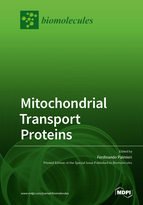Mitochondrial Transport Proteins
A special issue of Biomolecules (ISSN 2218-273X). This special issue belongs to the section "Cellular Biochemistry".
Deadline for manuscript submissions: closed (30 June 2021) | Viewed by 130731
Special Issue Editor
Interests: functional proteomics; membrane proteins; membrane transport; mitochondrial carrier biogenesis; mitochondrial carrier diseases; mitochondrial carrier identification; mitochondrial carrier transcriptional regulation; mitochondrial transport proteins; structure/function relationship; transport mechanism
Special Issues, Collections and Topics in MDPI journals
Special Issue Information
Dear Colleagues,
A Special Issue on “Mitochondrial transport proteins” is beeing prepared for the journal Biomolecules.
Mitochondrial transporters are membrane-inserted proteins that provide a link between metabolic reactions occurring in the mitochondrial matrix and outside the organelles by catalyzing the translocation of numerous solutes across the mitochondrial membrane. They include the mitochondrial carrier family members, the proteins involved in pyruvate transport, ABC transporters and channels, and are, therefore, essential for many biological processes and for cell homeostasis. Identification and functional studies of a large number of mitochondrial transporters have been performed over the years using both in vitro and in vivo systems. The few solved structures of these transporters have recently paved the way for further investigations. Furthermore, alterations in their function are responsible for several diseases. Original manuscripts and reviews dealing with any aspect of mitochondrial transport and related pathophysiology are very welcome.
Dr. Ferdinando Palmieri
Guest Editor
Manuscript Submission Information
Manuscripts should be submitted online at www.mdpi.com by registering and logging in to this website. Once you are registered, click here to go to the submission form. Manuscripts can be submitted until the deadline. All submissions that pass pre-check are peer-reviewed. Accepted papers will be published continuously in the journal (as soon as accepted) and will be listed together on the special issue website. Research articles, review articles as well as short communications are invited. For planned papers, a title and short abstract (about 100 words) can be sent to the Editorial Office for announcement on this website.
Submitted manuscripts should not have been published previously, nor be under consideration for publication elsewhere (except conference proceedings papers). All manuscripts are thoroughly refereed through a single-blind peer-review process. A guide for authors and other relevant information for submission of manuscripts is available on the Instructions for Authors page. Biomolecules is an international peer-reviewed open access monthly journal published by MDPI.
Please visit the Instructions for Authors page before submitting a manuscript. The Article Processing Charge (APC) for publication in this open access journal is 2700 CHF (Swiss Francs). Submitted papers should be well formatted and use good English. Authors may use MDPI's English editing service prior to publication or during author revisions.
Keywords
- mitochondrial transport proteins (MTPs)
- mitochondrial carriers
- MTP import
- MTP diseases
- MTPs in pathophysiology
- MTF structure
- MTF functional properties
- MTF structure/function relationships
- MTF tissue distribution
- MTF metabolic roles
- regulation of MTP transcription







